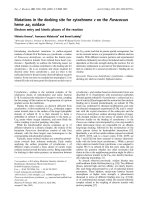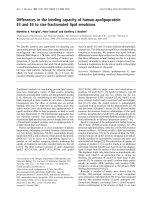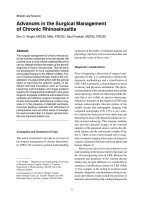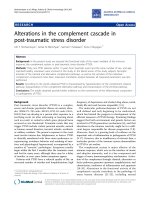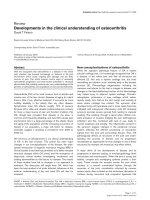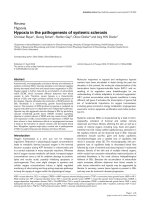Báo cáo y học: " Alarms in the intensive care unit: how can the number of false alarms be reduced" doc
Bạn đang xem bản rút gọn của tài liệu. Xem và tải ngay bản đầy đủ của tài liệu tại đây (146.05 KB, 5 trang )
Ptc
O2
= transcutaneous partial pressure of O
2
; Sp
O2
= saturation of oxyhemoglobin determined by pulse oximetry.
Critical Care August 2001 Vol 5 No 4 Chambrin
Many alarms, as they now exist in most monitoring
systems, are usually perceived as unhelpful by medical
staff because of the high incidence of false alarms; that is,
alarms with no clinical significance.
This paper gives an overview of the problems related to
the current design of alarms, and the objectives of moni-
toring. The current approaches used to improve the situ-
ation are then presented from two main standpoints:
organizational and behavioural on the one hand, and
technical on the other. ‘Organizational’ refers to the defi-
nition of a compromise between the use of heavy moni-
toring that induces many false alarms and the use of light
monitoring that can lead to the tardy detection of an
adverse incident. This orientation is approached through
recommendations such as those published by the
learned societies. The other standpoint concerns the
development of technical solutions: improvement in the
technology of some sensors to reduce artifacts, and the
use of multiparametric analysis to reduce the number of
false-positive alarms.
Objectives of the monitoring
Alarms are currently generated on crossing a limit. This
notion of limit is of course useful in determining physiological
limits of variation of a parameter but it is probably not the
best method of event detection. The information that the
clinician wants most of the time is the detection of relevant
abnormalities or changes in a patient’s condition. This is
not easily reflected in a value crossing a limit but rather by
the simultaneous evolution of different parameters. We
face a problem that is not merely technical but involves the
function and objectives of monitoring. A very interesting
review of goals and indications for monitoring is presented
by Pierson [1]. He recalls a definition of monitoring given
by Hudson: “Monitoring is making repeated or continuous
observations or measurements of the patient, his or her
physiological function and the function of life support
equipment, for the purpose of guiding management deci-
sions, including when to make interventions and assess-
ment of those interventions”. The physiological function is
supposed to be monitored through physiological parame-
ters that reflect that function more or less precisely. Moni-
toring then serves the purpose of maintaining a parameter
within ‘normal’ values. In practice, we can observe wide
variations in a given parameter without alteration of the
physiological function. That is what is generating false
alarms: in spite of being true for the monitoring device (the
parameter did cross the limit) they have no clinical signifi-
cance. Several studies in paediatric and adult critical care
Review
Alarms in the intensive care unit: how can the number of false
alarms be reduced?
Marie-Christine Chambrin
University of Lille, Lille, France
Correspondence: Marie-Christine Chambrin,
Published online: 23 May 2001
Critical Care 2001, 5:184–188
© 2001 BioMed Central Ltd (Print ISSN 1364-8535; Online ISSN 1466-609X)
Abstract
Many alarms, as they now exist in most monitoring systems, are not usually perceived as helpful by the
medical staff because of the high incidence of false alarms. This paper gives an overview of the
problems related to their current design and the objectives of monitoring. The current approaches
used to improve the situation are then presented from two main standpoints: organizational and
behavioural on the one hand, and technical on the other.
Keywords critical care, false alarm, patient monitoring
Available online />researchcommentary
review
reports meeting abstracts
units have been conducted to examine the relevance of
alarms in monitoring; they showed that less than 10% of
alarms do induce a therapeutic modification [2–4].
However, Tsien [3] mentioned that “not a single false neg-
ative alarm was recorded on 298 monitored hours”. The
same thing was observed by Lawless [2] and Chambrin
[4] studies (respectively 928 and 1971 monitored hours).
The fact that no major event that was related to worsening
of the patient’s status occurred without previous alarm
suggests that the current monitoring is effective in detect-
ing vital problems, but its low specificity might lead to
several adverse consequences. Alarms produce noise
louder than 80 dB that can lead to sleep deprivation [5,6]
and continuous stress for both patients and staff [7,8].
Such a constant demand may result in nurses delaying
their intervention, trying to recognize life-threatening alarms
by sound only. A study demonstrated that experienced
nurses are able to recognize only 38% of vital alarms [9].
This practice could therefore have severe consequences
when the patient’s condition is deteriorating. Different
approaches have been used to improve the situation.
Alarm generation and management
Currently available monitoring systems provide for the
setting of an alarm on most physiological data. This
creates a great number of potential alarms. Thus, it is pos-
sible to count more than 40 alarm sources, taking into
account ventilation data, electrocardiogram, arterial pres-
sure and pulse oximetry for a patient undergoing mechani-
cal ventilation. Alarms generated by the perfusion pump,
the nutrition pump, the automatic syringe and the dialysis
system, among others, must be added to this list. The
present technique used to generate an audible alarm
signal is based on setting a threshold. For every parame-
ter, the trigger of the alarm is set off immediately if its value
reaches the limit or in some cases when its value has been
beyond the limit for a given time. On the same monitoring
system, when the values of several parameters are beyond
the limit, an audible signal is triggered on the first parame-
ter that reached the alarm threshold; alternatively there
can be a hierarchy of alarms. In all cases it is necessary to
set the threshold alarm limit.
There is no standard for default alarm setting. For a given
parameter, this default setting can vary from one monitor-
ing system to another [10]. In some cases, the last set-
tings are taken into account as defaults for the new use of
the monitoring system. At least some systems provide a
procedure for determining the initial value from an initial
record of the parameters.
The priority in alarm management is first to recognize and
locate the source of the alarm and then to attribute a sig-
nificance to this alarm. For an experienced user, locating
the alarm is facilitated by the different sounds produced
by the equipment. What is bothersome is the repetition
and loudness of the alarms. Analysing the significance of
the alarm for the patient remains as the major difficulty.
At present, all available monitors provide reliable informa-
tion both on the value of a given parameter and for the
recognition of some events. An alarm event in a cardiovas-
cular monitor can be a technical defect, such as a bad
electrode position, or a high level of signal interpretation,
such as an arrhythmia. The problem is no longer purely at
the level of signal analysis but at the level of management
of the data for alarm generation. At present, audible alarms
are generated only on a limit value, whatever the data are:
there is no gradation related to the degree of urgency. For
example, a disconnection of the patient from the ventilator
produces the same audible alarm as a high level of minute
ventilation. In the first case, the alarm is vital for the patient
and independent of any setting. The second case could
be related to the setting of the ventilator and is not imme-
diately prejudicial to the patient.
Standards and recommendations
This concept of urgency has been adopted by several
committees for normalization that define standards for
medical devices, in respect of electrically generated alarm
signals. For example, the European Committee for Stan-
dardization (CEN: Comité Européen de Normalisation) has
established a classification of the alarms in three cate-
gories [11]: high priority, indicating an urgent situation
(one that can lead immediately to a vital problem; this
requires an immediate response from the medical staff);
medium priority, indicating a dangerous situation (a quick
response from the medical staff is needed); and low prior-
ity, indicating an alert situation (the attention of medical
staff is needed). A precise description of the signal com-
position is given in terms of its characteristics in time and
frequency according to the level of priority, resulting in a
sequence of notes in a distinctive rhythm for each level.
However, this standard gives no indication of the condi-
tions required to produce an alarm of a given priority. This
information is given in other standards related to specific
medical devices.
For example, according to the standard corresponding to
the ventilator [12], alarms of high priority are those related
to electrical or pneumatic failure, or high airway pressure.
Disconnection, apnoea, low expiratory minute ventilation
or high or low concentration of dioxygen during inspiration
are considered to be alarms with at least a medium prior-
ity. This notion of vital alarm is also described by Sanborn
[13], who mentions that only ventilator failure, disconnec-
tion and obstruction require immediate intervention and
then should require an audible alarm.
In the standard related to capnography [14], it is specified
that when a capnograph is used with an objective of moni-
toring and not only as a tool for exploration, it should
Critical Care August 2001 Vol 5 No 4 Chambrin
provide alarms of medium priority for high and low end
tidal CO
2
values and a high concentration of carbon
dioxide during inspiration.
The standard related to pulse oximetry [15] specifies that
when an oximeter is used for monitoring purposes, it
should provide an alarm for a low saturation of oxyhemo-
globin determined by pulse oximetry (Sp
O2
). If a default
value is provided, it should be more than 80%. When
used in neonatology, an alarm for a high Sp
O2
should be a
supplementary factor of safety.
These standards provide the following: on one side, a
classification of the alarms according to a level of emer-
gency (high, medium and low) with audible characteristics
corresponding to each of these levels, and on the other
side, for each monitoring system, the events or parameters
that should provide an audible alarm with a given degree
of emergency (Table 1).
Very few monitoring systems currently use these stan-
dards, and to our knowledge there are no data to say
whether or not such an implementation would improve
alarm management.
Because the number of false alarms increases as the
number of monitors increases [16], one method should be
to optimize the level of monitoring. This is approached
through some recommendations edited by the American
Association of Respiratory Care (AARC) on the use of
some monitoring systems such as capnography [17] and
pulse oximetry [18] (see also />~shrp/rtwww/rcweb/aarc/). These recommendations,
based on a review of the current literature, provide for each
monitor information such as indications, contraindications
and assessment of need. More recently, the Société de
Réanimation de Langue Française (SRLF) published rec-
ommendations for the monitoring of ventilated patients
according to pathology, mode of ventilation and age [19].
Technical and research studies
Many studies have shown that the number of false alarms
on the Sp
O2
signal is particularly important because of
bad connections and poor contact [2–4]. They are more
often due to motion artifact. In the current clinical context,
switching off the redundant alarms is a solution that can
be considered if the patient’s safety is assured. For
example, in the paediatric context, except for severe respi-
ratory distress syndrome, an alarm on high and low values
for Sp
O2
and on the transcutaneous partial pressure of O
2
(Ptc
O2
) is not justified, even if these alarm settings are oth-
erwise justified for the preterm infant. It is therefore possi-
ble to choose to switch on an alarm on a low Sp
O2
and a
high Ptc
O2
and to switch off the alarm on a high Sp
O2
and
Table 1
Classification of alarms according to the existing standards
Type of alarm Alarm category Note Standard
Electric or pneumatic failure High priority EN 794–1 [12]
FI
O2
high or low At least medium priority Is applicable as soon as O
2
concentration is EN 794–1
different from that of ambient air
Paw high High priority EN 794–1
VE low* or VT low* At least medium priority EN 794–1
Apnoea At least medium priority EN 794–1
Disconnection At least medium priority Could be detected for example from a low Paw, EN 794–1
a low ET
CO2
and a low tidal volume
Continuous pressure High priority Is relative to a continuous pressure kept over a EN 794–1
given limit during more than 15 ± 1.5 s
ET
CO2
High Medium priority EN 864 [14]
Low Medium priority EN 864
FI
CO2
high Medium priority EN 864
Sp
O2
High No priority indicated For neonatology EN 865 [15]
Low No priority indicated EN 865
Sensor failure Low or medium priority EN 865
*According to these standards, except for the ventilators used in neonatology, the measurement of expiratory tidal volume (VT) or minute ventilation
(VE) must be provided. Only the parameters and events listed in the standards are reported here. The values of high and low alarm limits are set by
the medical staff. An alarm of high priority implies an immediate response from the staff; an alarm of medium priority implies a prompt response from
the staff; an alarm of low priority is used to attract staff’s attention. ET
CO2
, end tidal CO
2
; FI
CO2
, concentration of carbon dioxide during inspiration;
FI
O2
, concentration of dioxygen during inspiration; Paw, airway pressure; Sp
O2
, saturation of oxyhemoglobin determined by pulse oximetry.
a low Ptc
O2
[20]. Technical solutions have been proposed
by some manufacturers. A new technology approach,
termed Masimo Signal Extraction Technology (Masimo,
Irvine, California, USA; see />cal.htm), was introduced recently; when tested on healthy
volunteers during standardized motion procedures, this
technology showed lower error rates than those of other
oximeters [21]; a clinical study conducted in a paediatric
critical care unit confirmed these results [22].
Some research studies have been conducted to decrease
the number of false alarms. In a study by Rheineck-Leys-
sius and Kalkman [23] performed off-line on data for 200
post-operative patients, the authors compared the effect
of different methods on the number of true and false
alarms: alarm delay (2–44 s) with an alarm limit set to
90%, a mean and median filter (10–90 s) and decreasing
the alarm limit from 90% to 85%. Results showed that in
this specific context, it might be preferable to use a longer
filtering epoch rather than to decrease the lower alarm
limit. The use of median filtering techniques seems an
interesting solution to the problem of decreasing the
number of false alarms for data coming from the ventilator
[24] as well as those coming from the cardiovascular
monitor [25]. In this last study, the results showed that the
frequency of false alarms was reduced by more than two-
thirds compared with a typical patient monitor.
As well as these monoparametric approaches, a multipara-
metric approach such as data fusion has been explored: it
is a method designed to compute data from multiple
sensors and to use the redundancy to improve the quality
of the information produced in terms of the quality of the
monitored data and alarm management. This approach is
particularly suitable for heart rate, which can be obtained
from different sources (every derivation of the electrocar-
diogram signal, Sp
O2
and arterial pressure) [26].
Most of the studies are seeking to reduce the number of
false alarms (those with no clinical significance) by using
multiparametric approaches: most of the time it is the
simultaneous variation of several parameters that is char-
acteristic of an event. Probably the use of limits is useful to
ensure the physiological range of a parameter but, except
in specific cases that are more frequent in neonates (the
detection of hyperoxy), the control of limit violation for a
parameter is not what the physician is looking for. He is
looking for events (such as airway obstruction, true
haemoglobin desaturation and hypovolaemia). The knowl-
edge of experts in the field is then used to determine
episodes of artifact or specific events. Many studies have
been conducted in this way [27–31]. More often, the
medical knowledge is expressed in terms of an increase, a
decrease, the stability or the instability of a parameter. In
this approach, it is the trend or the pattern of the parame-
ter more than its current value that is taken into account.
The results seem promising, but on-line clinical validation
is needed to compare the performance of such systems
with current monitoring in detecting false alarms. On-line
documentation of the events and the development of mul-
tiparametric procedures on the available data are other
perspectives that are being explored. Rather than using
expert knowledge first, we are trying to extract the relation-
ships directly from the data [32] and to compare our find-
ings with what has happened in the clinical context.
Conclusion
The review of the current literature permits the conclusion
that the present monitoring is safe but the mode of alarm
generation is the source of many false alarms if we con-
sider a false alarm as an alarm with no clinical relevance.
Currently there is no obvious solution, but some improve-
ment could be made by following two main objectives: the
adaptation of the choice of the element of monitoring to
each patient, and the development of technical solutions
with multiparametric approaches to detect events that are
clinically relevant.
Acknowledgements
I thank Professor Claude Chopin for stimulating discussions on the role
of monitoring: I am just an observer; he is a practitioner. I also thank
Janette Andre, who corrected the English manuscript.
References
1. Pierson DJ: Goals and indications for monitoring. In Principle
and Practice of Intensive Care Monitoring. Edited by Tobin MJ.
New York: McGraw-Hill, Inc; 1998:33–44.
2. Lawless ST: Crying wolf: false alarms in a pediatric intensive
care unit. Crit Care Med 1994, 22:981–985.
3. Tsien CL, Fackler JC: Poor prognosis for existing monitors in
the intensive care unit. Crit Care Med 1997, 25:614–619.
4. Chambrin MC, Ravaux P, Calvelo D, Jaborska A, Chopin C, Boni-
face B: Multicentric study of monitoring alarms in the adult
intensive care unit (ICU): a descriptive analysis. Intensive Care
Med 1999, 25:1360–1366.
5. Meyer TJ, Eveloff SE, Bauer MS, Schwartz WA, Hill NS, Millman
RP: Adverse environmental conditions in the respiratory and
medical ICU settings. Chest 1994, 105:1211–1216.
6. Balogh D, Kittinger E, Benzer A, Hackl JM: Noise in the ICU.
Intensive Care Med 1993, 19:343–346.
7. Aaron JN, Carlisle CC, Carskadon MA, Meyer TJ, Hill NS, Millman
RP: Environmental noise as a cause of sleep disruption in an
intermediate respiratory care unit. Sleep 1996, 19:707–710.
8. Kam PCA, Kam AC, Thompson JF: Noise pollution in the anaes-
thetic and intensive care environment. Anaesthesia 1994, 49:
982–986.
9. Cropp AJ, Woods LA, Raney D, Bredle DL: Name that tone: the
proliferation of alarms in the intensive care unit. Chest 1994,
105:1217–1220.
10. Koski EM, Maakivirta A, Sukuvaara T, Kari A: Clinician’s opinions
on alarm limits and urgency of therapeutic responses. Int J
Clin Monit Comput 1995, 12: 85–88.
11. Comité Européen de Normalisation. European Standard. Medical
devices. Electrically generated alarm signals. EN 475:1995.
12. Comité Européen de Normalisation. European Standard. Lung
ventilators. Part 1: Particular requirements for critical care ventila-
tors. EN 794-1:1997.
13. Sanborn WG: Microprocessor-based mechanical ventilation.
Respir Care 1993, 38:72–109.
14. Comité Européen de Normalisation. European Standard. Medical
electrical equipment. Capnometers for use with humans. Particu-
lar requirements. EN 864:1996.
Available online />researchcommentary
review
reports meeting abstracts
Critical Care August 2001 Vol 5 No 4 Chambrin
15. Comité Européen de Normalisation. European Standard. Pulse
oximeters. Particular requirements. EN 865:1997.
16. Kacmarek R: Alarms. In Principle and Practice of Intensive Care
Monitoring. Edited by Tobin MJ. New York: McGraw-Hill, Inc;
1998:133–139.
17. AARC Clinical Practice Guideline: Capnography/capnometry
during mechanical ventilation. Respir Care 1995, 40:
1321–1324.
18. AARC Clinical Practice Guideline: Pulse oximetry. Respir Care
1991, 36:1406–1409.
19. Recommandations d’experts de la SRLF: Le monitorage et les
alarmes ventilatoires des malades ventilés artificiellement.
Réanim Urgences 2000, 9:407–412.
20. Chambrin MC, Storme L, Lemoine D, Usselio A: Les alarmes des
paramètres monitorés: principes généraux et gestion. Réanim
Urgences 2000, 9:432–438.
21. Barker SJ, Shah NK: Effects of motion on the performance of
pulse oximeters in volunteers. Anesthesiology 1996, 85:
774–781.
22. Bohnhorst B, Peter CS, Poets CF: Pulse oximeters’ reliability
in detecting hypoxemia and bradycardia: comparison
between a conventional and two new generation oximeters.
Crit Care Med 2000, 28:1565–1568.
23. Rheineck-Leyssius AT, Kalkman CJ: Influence of pulse oximeter
settings on the frequency of alarms and detection of hypox-
emia: theoretical effects of artifact rejection, alarm delay,
averaging, median filtering or a lower setting of the alarm
limit. J Clin Monit Comput 1998, 14: 151–156.
24. Young WH, Gardner RM, East TD, Turner K: Computerized ven-
tilator data selection: artifact rejection and data reduction. Int
J Clin Monit Comput 1997, 14:3, 165–176.
25. Mäkivirta A, Koski E, Kari A, Sukuvaara T: The median filter as a
preprocessor for a patient monitor limit alarm system in
intensive care. Comput Methods Programs Biomed 1991, 34:
139–144
26. Feldman JM, Ebrahim MH, Bar Kana I: Robust sensor fusion
improves heart rate estimation: clinical evaluation. J Clin
Monit 1997, 13:379–384.
27. Koski EM, Sukuvaara T, Mäkivirta A, Kari A: A knowledge-based
alarm system for monitoring cardiac operated patients:
assessment of clinical performance. Int J Clin Monit Comput
1994, 11:79–83.
28. Schoenberg R, Sands DZ, Safran C: ICU alarms meaningful: a
comparison of traditional vs trend-based algorithms. Proc
AMIA Symp 1999, 379–383.
29. Cao C, McIntosh N, Kohane I, Wang K: Artifact detection in the
PO2 and PCO2 time series monitoring data from preterm
infants. J Clin Monit Comput 1999, 15:369–378.
30. Hunter J, McIntosh N: Knowledge-based event detection in
complex time series data. In Lecture Notes in Artificial Intelli-
gence 1620. Edited by Horn W, Shahar, Lindberg, Andreasson,
Wyatt. Berlin: Springer-Verlag; 1999:271–280.
31. Haimowitz IJ, Kohane IS: Managing temporal trend diagnosis.
Artif Intell Med 1998, 8:299–321.
32. Calvelo D, Chambrin MC, Pomorski D, Ravaux P: Towards sym-
bolization using data-driven extraction of local trends for ICU
monitoring. Artif Intell Med 2000, 19:203–223.
